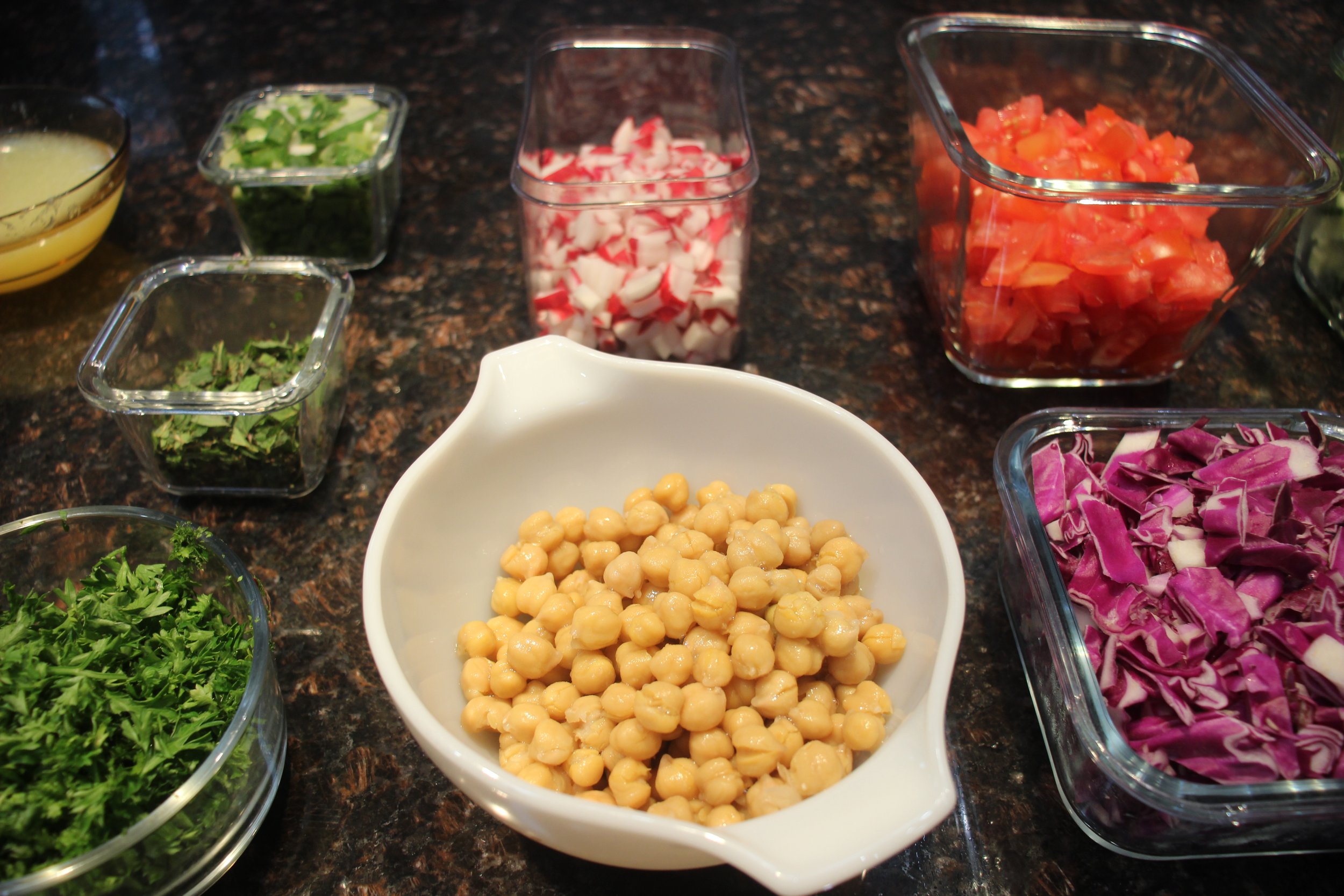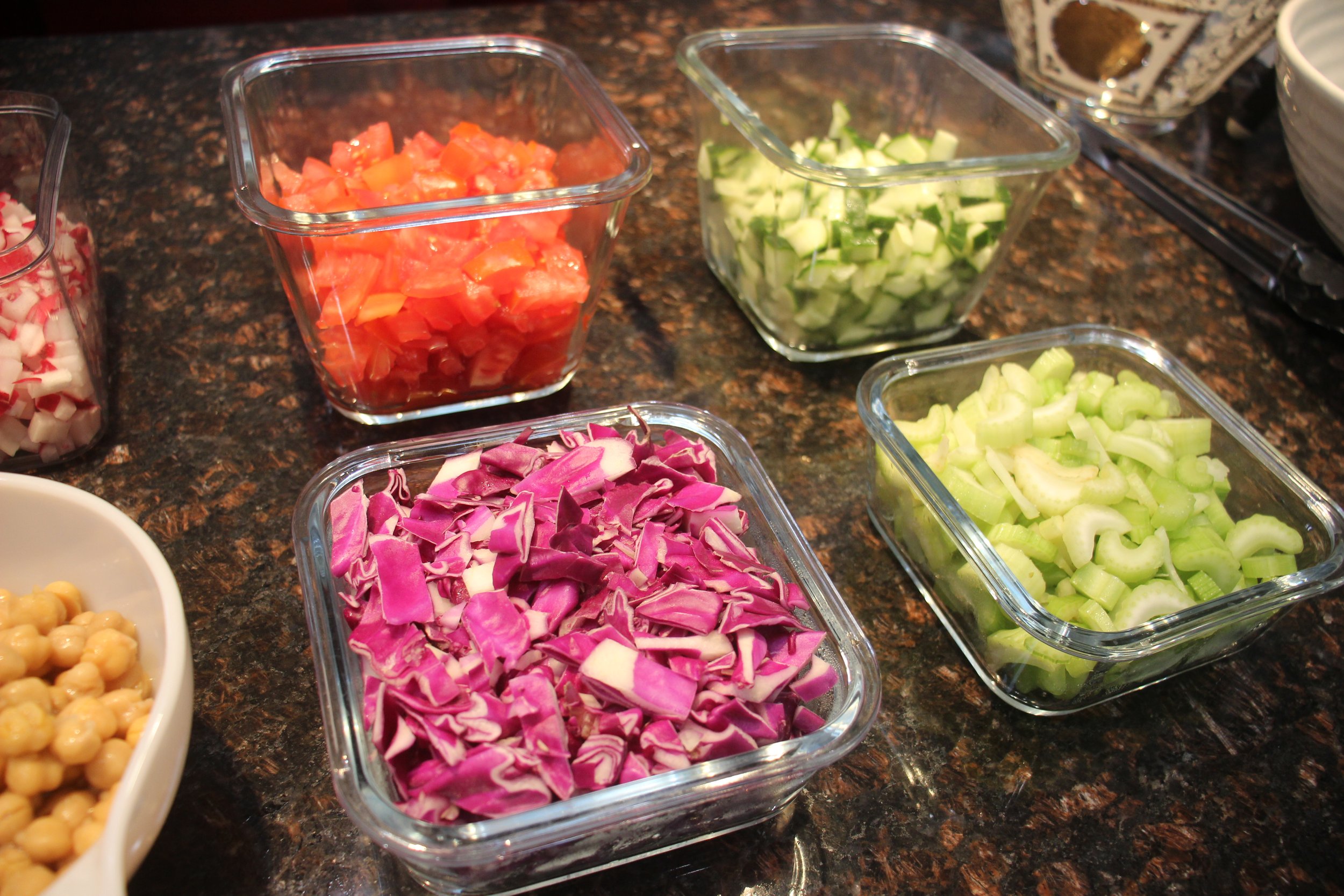“Mommy’s Salad”
When is a salad not just a salad?
By Z.Z. Dawod
“Mommy’s Salad,” as it was named by her children, is not just a salad—it’s a meal.
On most dinner menus, salads tend to play a supporting role, served in small portions at the start of a meal. However, West Bloomfield resident Aida Yousif has taken the concept of a salad to a new level by elevating it to a full meal. Among family and friends, “Mommy’s Salad” is a favorite and has been at the top of the request list for many years.
Background
While she was raising her children, Aida’s goal was to always incorporate salads into their diet, to get her family accustomed to eating fresh fruits and vegetables on a regular basis. On the day I visited her home, Aida made her priorities categorically clear, exclaiming, “Using fresh ingredients makes it healthy, and completing it with a protein makes it fulfilling.”
As far back as she can remember, Aida has not used pre-mixed dressings to complete her salads. She never cared for what she calls that “fake taste” growing up. Instead, she appreciated the timeless simplicity of lemon, oil, and salt. A sprinkle of sumac was added to give the dish a traditional homemade flavor.
Over the years, as her children were growing, Aida would experiment with a variety of vegetables and fruits, in search of the perfect combination. She also discovered that the order in which ingredients are added is a factor and, according to her, makes all the difference.
History and Origin
Why do we call it salad? The origin of the word is “sal,” which is Latin for “salt.” Provencal usage was salada and the old French term became salade. By the late Middle English period, the modern-day spelling salad was adopted.
According to food historians, salads date back to ancient Greek and Roman societies. In classical times, a simple selection of raw vegetables came to be dressed with oil, vinegar and, most importantly, salt — the key ingredient which gave this dish its universal name. As more ingredients were added, salad recipes evolved based on availability of ingredients and varying local climates.
Mommy’s Salad Preparation
To prepare “Mommy’s Salad,” Aida always starts with a bed of washed and chopped romaine lettuce. Romaine is one of the most common varieties of lettuce used in Iraq and throughout the Middle East, where it also happens to be the base ingredient in the Fattoush — one of the most commonly-known Middle Eastern salads. However, that’s pretty much where the similarities end because, over the years, Aida has developed her own unique blend of ingredients for her recipe.
English cucumbers are added next. Aida always uses this variety because, she says, “They often have little or no seeds, with a sweeter flavor. [They are] also less watery.”
After the cucumbers come the vine tomatoes. “These are definitely the best variety to use because they have a longer harvest, which gives them that extra time on the vine, making them extra sweet and juicy,” she declares.
The next three vegetables are red cabbage, celery, and radish. “These have been a favorite addition thanks to their extra crunchy texture, so the salad is not soggy,” she continues. Each ingredient is added on top of the last and Aida does not begin mixing until the very end.
Her choice of onion is the green onion, which is the final vegetable to be added. After experimenting extensively, Aida has formed strong preferences for particular varieties. “I like the green onions; while they are milder than sweet onion, they have lots of flavor,” she says.
With all vegetables and the tomatoes added, the fresh herbs are next on the chopping block. First, Aida adds the curly parsley. “I prefer the curly variety because, to my taste buds, it has more of a ‘green flavor.’ Also, it has a bit of a crunch, compared to the Italian flat-leaf parsley, which tends to, sometimes, have a bitter taste.” The next herb is fresh mint. “The mint gives the salad that extra burst of flavor,” Aida adds, excitedly.
Chickpeas are added next, for that all-important protein, to complement the mix and to create a nice balance with the vegetables, fruit, and herbs.
After a long day, “I don’t want to eat something heavy,” Aida says. If there is not much time to cook, she tops the salad with chickpeas for protein, to make a complete meal. Chickpeas are perfect as a meat alternative.
It’s worth noting that chickpeas are also known as garbanzo beans. While the two names sound completely unrelated, they are in fact the same bean. “Chickpea” is the common English term, while “Garbanzo” is a Spanish word. Whatever you prefer to call them, these beans have been part of the Middle Eastern diet for almost 10,000 years, sharing different names across many cultures.
With fresh ingredients like these it’s hard to go wrong, but dressing this mixture is what makes Aida’s salad so special. Her perfected blend begins by sprinkling the sumac and dry mint. That’s right—she adds dry mint in addition to the fresh mint because it helps to expand the flavor. While the fresh mint provides the initial blast of fragrance, dry mint helps the taste to linger until the end of each delicious bite.
Aida tops that with a mixture of equal-part lemon and lime juice. Next, she adds the Greek olive oil, from a treasured bottle, gifted by her son after his honeymoon trip to Greece. And for the grand finale, the Himalayan sea salt. “This salt creates a perfect balance and highlights all the flavors,” she says.
RECIPE
Mommy’s Salad
Recipe shared by Aida Yousif
Ingredients:
Romaine lettuce
English cucumbers
Vine ripe tomatoes
Radish
Red cabbage
Celery
Green onions
Curly parsley
Fresh mint
Chickpeas
Sumac + dry mint
Lemon/lime juice mixture
Greek olive oil
Himalayan sea salt
Mixing Instructions:
Add the vegetables, fruit and herbs in the order listed above. Salt must be added last to capture the flavor of all the ingredients. When the salt is added, “you will taste the magic,” infused with sumac, dry mint, olive oil and lemon-lime mixture, bringing out a more intense flavorful taste of all the vegetables and chickpeas.





